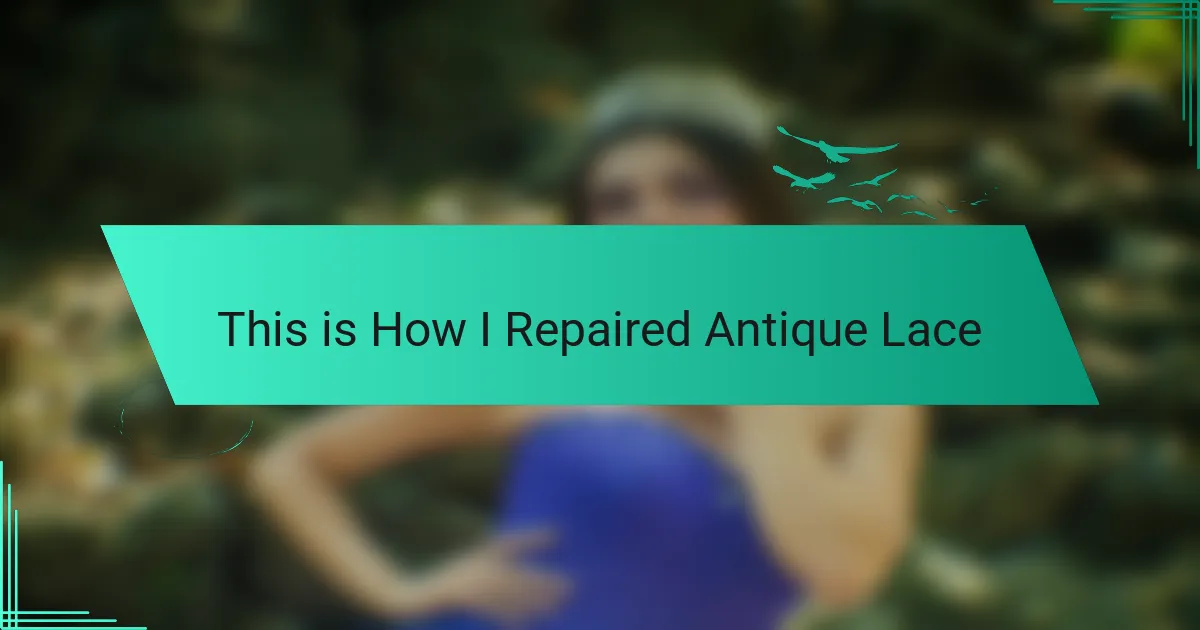Key takeaways
- Repairing antique lace requires a delicate touch, with techniques varying based on the type of lace, such as Needle Lace and Bobbin Lace.
- Using appropriate tools, such as fine-tipped tweezers and small scissors, is essential to ensure careful and precise restoration.
- Regular maintenance, including gentle cleaning and proper storage, is crucial for preserving the beauty and lifespan of vintage fashion items.
- Personal experiences in repair highlight the emotional connection to history and the rewarding nature of restoring cherished heirlooms.
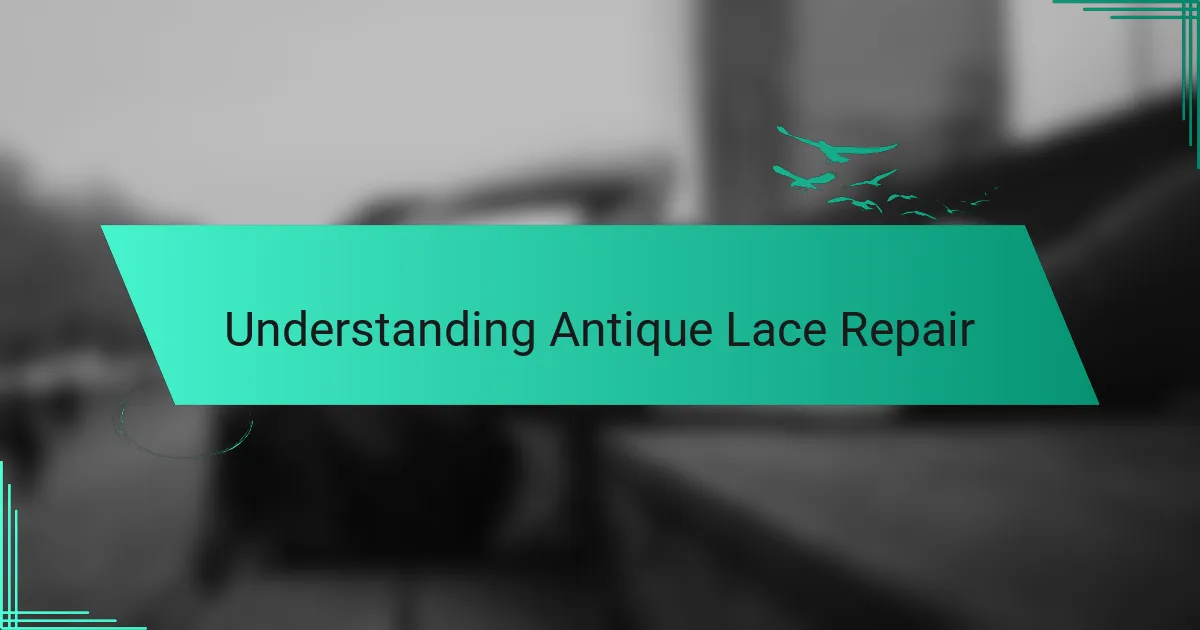
Understanding Antique Lace Repair
When I first encountered antique lace, I was overwhelmed by its delicate beauty and the stories woven into its threads. Understanding how to repair such fragile fabric is essential, as each piece has its own story, often reflecting the craftsmanship of another era. Have you ever held something so exquisite that you felt a sense of responsibility to preserve its history?
I remember the moment I discovered a cherished heirloom lace handkerchief, frayed and in need of care. The right repairs require a gentle touch and sometimes a bit of research – knowing the type of lace can guide your approach. For instance, identifying whether it’s Needle Lace or Bobbin Lace can change your repair strategy entirely.
Moreover, I find that gathering the right materials is equally as important. When I repaired a treasured lace collar, I searched for threads and needles that matched not just the color but also the texture of the original fabric. Using the appropriate tools makes the repair process smoother and helps maintain the antique’s integrity, allowing it to continue telling its story for generations to come.

Importance of Vintage Fashion Care
Taking care of vintage fashion items, like antique lace, is crucial for preserving their beauty and history. I remember the first time I noticed the delicate craftsmanship of an antique lace piece; it deeply moved me. I realized that each thread holds stories from the past, and it’s our responsibility to keep them intact for future generations.
Proper maintenance not only enhances the aesthetic appeal but also prolongs the lifespan of these treasures. In my experience, an ounce of prevention is worth a pound of cure when it comes to vintage garments. Each careful action, from gentle cleaning to proper storage, can make a significant difference.
- Inspects items regularly for signs of wear or damage.
- Uses acid-free materials for storage to avoid deterioration.
- Cleans antique lace gently using mild detergents and lukewarm water.
- Avoids exposure to direct sunlight, which can cause fading.
- Handles with clean hands to prevent transferring oils or dirt.
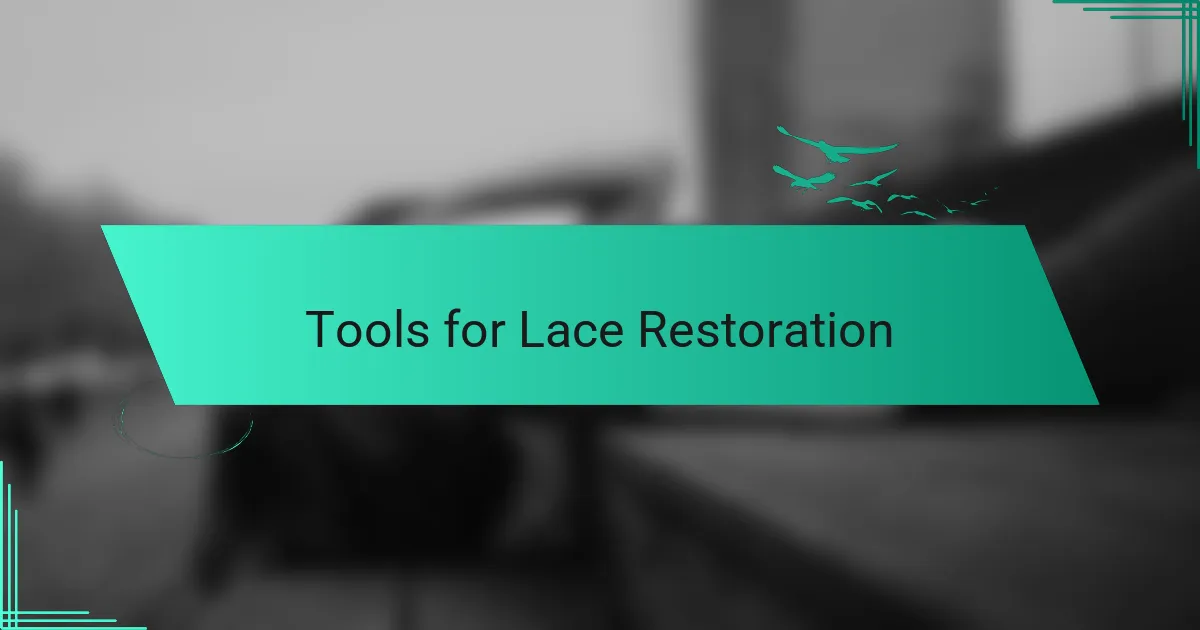
Tools for Lace Restoration
Restoring antique lace can be a delicate endeavor, and having the right tools makes all the difference. I remember my first attempt at repairing a beautiful lace handkerchief passed down from my grandmother. It was a labor of love, and using the proper tools helped me handle the lace with care and precision, enhancing my enjoyment of the process.
Here’s a list of essential tools for lace restoration that I’ve found invaluable:
- Fine-tipped tweezers: Perfect for picking threads without tugging.
- Small scissors: Ideal for trimming loose threads without damaging the lace.
- Embroidery needles: Thin needles work best to avoid creating extra holes.
- Lace weight: Helps keep delicate pieces stable while you work.
- Soft brush: Great for gently removing dust or dirt without abrasion.
- Fabric glue: Useful for securing small tears or areas that need reinforcement.
Investing in these tools not only aids in the restoration process but also brings a sense of satisfaction when you see the lace come back to life under your hands.
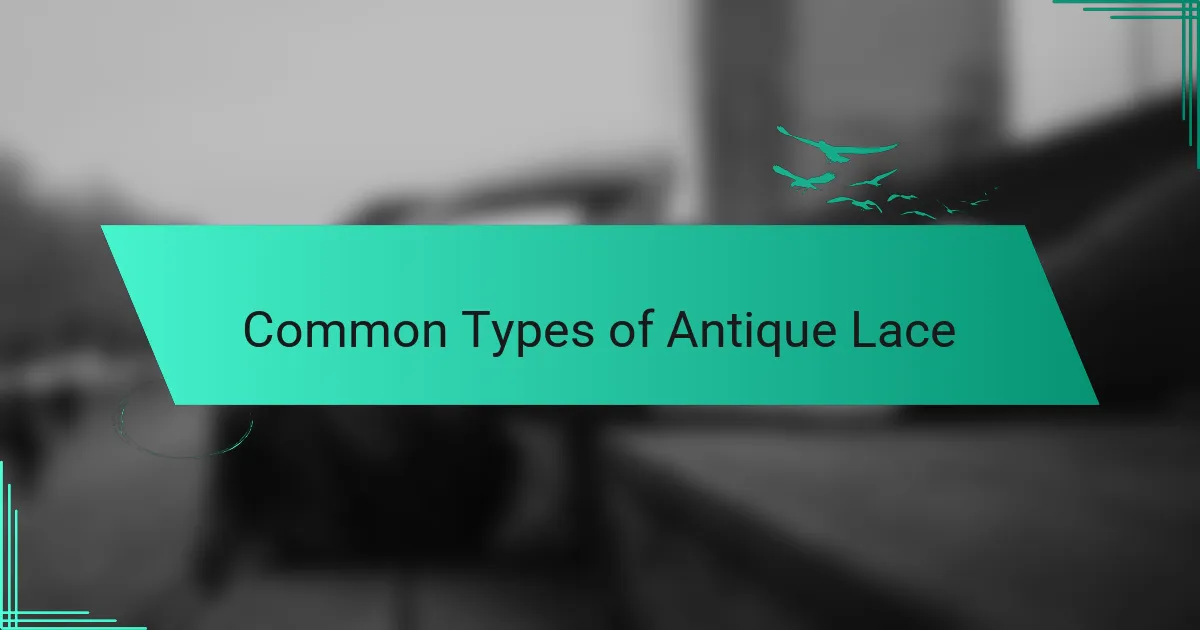
Common Types of Antique Lace
When I think about the various types of antique lace, a few specific styles stand out to me. For example, Needle Lace is one of my favorites. Each piece is meticulously crafted by hand-stitching threads together to form intricate patterns. I recall the first time I saw a vintage needle lace doily; the detail was so fine that it felt almost like artwork.
Then there’s Bobbin Lace, which captivates me with its unique technique. This lace is created by braiding and twisting threads using bobbins, and it often features beautiful geometric designs. I remember being in awe while watching a skilled artisan work with bobbins, their fingers dancing as they brought the lace to life. Have you ever tried making bobbin lace? It’s a fascinating blend of creativity and precision.
Lastly, Crocheted Lace holds a special place in my heart. I come across pieces made by my great-grandmother that carry her essence in each loop and stitch. Crocheted lace is typically crafted with a hook and has a relaxed, organic feel compared to other types. It makes me wonder how many hands have passed over these stitches before mine, connecting me to the past in such a tangible way.
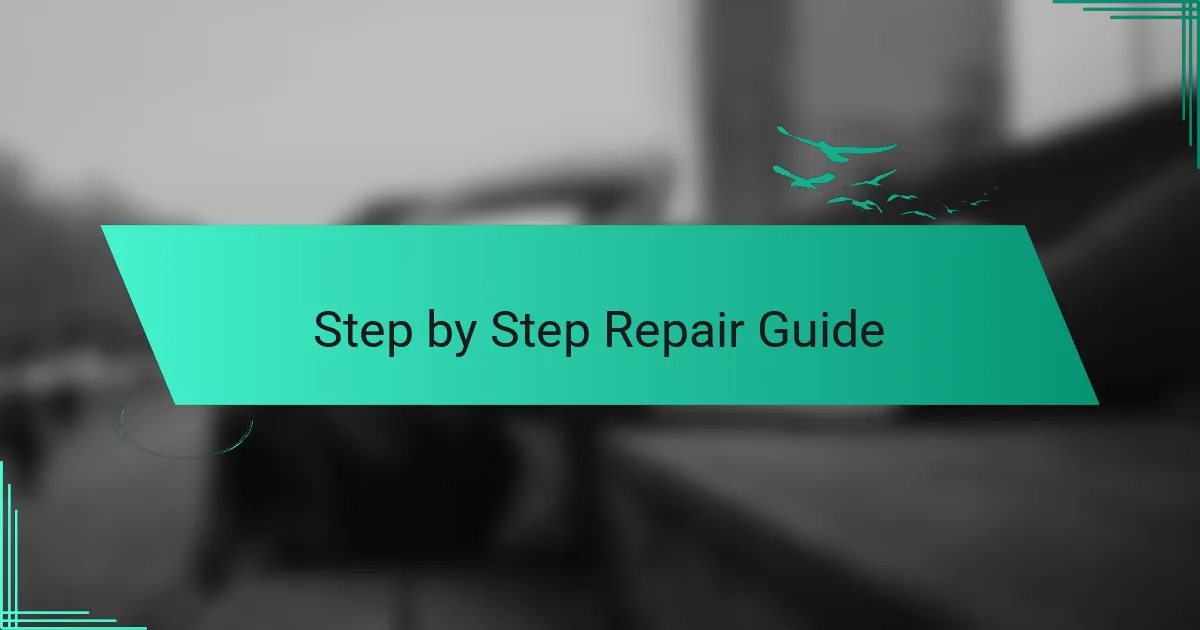
Step by Step Repair Guide
Repairing antique lace can be a delicate process, but it’s incredibly rewarding. First, examine the lace carefully to identify damaged areas—this is where you’ll want to put your focus. In my experience, working in a well-lit space with a magnifying glass can make a significant difference.
Once you’ve identified the damage, use fine thread matching the lace color to carefully stitch any tears or holes. I remember the first time I did this; it felt like piecing together a puzzle, and the satisfaction of restoring the lace was unparalleled. While it may require patience, knowing that you’re preserving a piece of history makes it worthwhile.
Here’s a quick comparison of different repair techniques:
| Technique | Description |
|---|---|
| Invisible Mending | Using matching thread and fine stitches to blend repairs seamlessly. |
| Patch Method | Applying a small piece of similar fabric underneath the lace to reinforce weaker areas. |

Personal Experiences with Lace Repair
When I first attempted to repair an antique lace piece that had been passed down from my grandmother, I was filled with both excitement and trepidation. I remember carefully examining the delicate threads and feeling a sense of connection to the countless hands that had touched it before me. The process wasn’t just about fixing; it was about preserving a part of my family’s history. I found joy in weaving new threads through the worn-out sections, transforming what once felt fragile into something renewed and cherished.
One particularly memorable moment was when I discovered that certain patterns in the lace were actually a homage to the craftsmanship of the era. As I worked on it, I felt like a part of this intricate tradition, connecting with artisans from generations ago. Each knot and stitch came with its own emotional weight, reminding me of the beauty of maintaining such fragile treasures.
In my experience, patience is key. I’ve learned that taking the time to treat antique lace with care not only allows for better repairs but also makes the journey of restoration incredibly fulfilling. Here’s a quick comparison of two methods I’ve tried for repairing lace—needlework and fabric glue:
| Technique | Advantages |
|---|---|
| Needlework | Offers a traditional and durable repair, maintains the integrity of the lace, allows for creative stitching. |
| Fabric Glue | Quick and easy to apply, no special skills required, can be less intrusive on the delicate fabric. |
